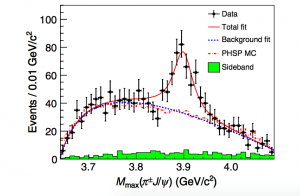
Hadrons, particles that interact through the strong force, are usually classified according to their spin: mesons have integral spin and are generally composed of a quark–antiquark pair; baryons have fractional spin and are composed of three quarks or anti-quarks. Exceptions to this two/three quarks configuration are of particular interest since they may represent a new configuration of matter, indeed called “exotic”.
Quantum chromodynamics (QCD) is the theory that describes strong interactions between quarks and, for its nature, can make predictions broadly confirmed at high energy; the hardest part is describing the quarks’ behavior at low energy, where they bind together into hadrons. Thus, at the moment, we cannot unambiguously state which quark configurations are allowed and which are not. However several theoretical models predict the existence of exotic hadrons made of four or five quarks (tetraquarks or pentaquarks) or hybrid hadrons (containing – besides the quarks – one gluon) or even glueballs (only gluons bound together).
To the present day, scientists have discovered about thirty possible particles which do not fit the standard meson/baryon classification and for this reason were named exotic. Most of these candidates have mass within the region of the so-called charmonium states, neutral mesons made of a charm quark and an anti-charm quark. The X(3872) can be considered the first exotic state, supposed to be a tetraquark, but its nature is still unclear.
The BESIII experiment at the e+e– collider BEPCII in Beijing is precisely dedicated to the systematic study of charm states in a wide range of energies and has recently discovered a series of particles definitely exotic composed of four quarks. On the other hand, studying the particles coming from the B meson decay produced in the proton-proton collisions at CERN LHC collider, the LHCb Collaboration is unveiling new exotic structures.
At an energy of 4.26 GeV the collisions between electrons and positrons produce an enigmatic particle, the Y(4260), which seems to be composed of a charm-anticharm pair and an extra gluon. In the effort to reveal the Y(4260) peculiarities in its decay into a J/ψ meson and two (π+ e π–) pions, physicists of BESIII, immediately followed by those of Belle at the Japanese KEK accelerator, discovered another enigmatic particle, the Zc(3900), with a mass which is about four times that of the proton. It became clear that the Y(4260) decay occurs through an intermediate state, consisting of the Zc(3900), which in turn decays into a J/ψ meson and a π+ o π– (see the figure). The J/ψ is a charmonium state, that is a charm-anticharm combination with no electrical charge. Its presence among the Zc decay products is a clear signal that the latter must also contain a charm-anticharm pair. To conserve electrical charge in the decay reactions Zc(3900) → J/ψ π+ and Zc(3900) → J/ψ π–, the Zc must have the same electrical charge of the pion into which it decays. Since the only way to realize an integral electrical charge is having at least a quark-antiquark pair (single quarks own fractional electric charges), the Zc must contain other two quarks -besides the charm and anticharm – which makes this particle a possible tetraquark candidate.

Such a four-quark combination had never been observed before and its discovery led BESIII collaboration to study other reactions that can bring to the production of these tetraquarks and the whole theoretical physicists community started to investigate their nature. In this research BESIII also identified the neutral partner of the Zc(3900) and, at a mass of 4.02 GeV, they discovered other three particles made of four quarks, called Zc(4020). Two have an electrical charge, the other one is neutral. Furthermore, in the Y(4260) decay into a pion and a pair made of a D meson and its antiparticle it was also identified a particle with mass of 3.885 GeV, very close to the Zc(3900)!
In a recent paper appeared in Physical Review Letters [1], BESIII collaboration reported the results of a measurement of the spin and parity of both this particle and the Zc(3900). These results indicate that both the particles have spin 1 and positive parity, which supports the idea that the two particles are actually the same four-quark particle having two different possible decay modes: into J/ψ π+(π–) or into a D meson-anti D meson pair and a pion.
The LHCb Collaboration has recently reported (Physical Review Letters [2]) the observation of four exotic particles decaying into a J/ψ and a φ meson: X(4140), X(4274), X(4500) and X(4700) (only the former had already been observed by previous experiments) and they are all further tetraquark candidates.
From a theoretical point of view, the efforts to solve QCD at low energies might reveal whether configurations of four or more quarks are possible and the current particle-classification should be revised in light of these recent observations. (Monica Bertani)
[1] – The paper is freely downloadable at arxiv.org/abs/1706.04100 [2] – The paper is freely downloadable at arxiv.org/abs/1606.07895
Translation by Camilla Paola Maglione, Communications Office INFN-LNF
 INFN-LNF Laboratori Nazionali di Frascati
INFN-LNF Laboratori Nazionali di Frascati